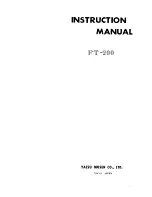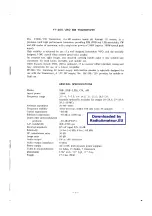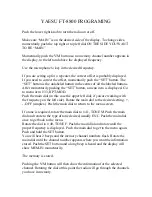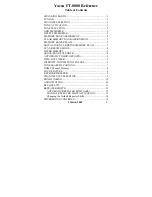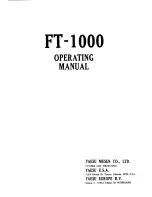
CC2500
SWRS040C
Page 24 of 89
by the radio hardware (e.g.
MARCSTATE
or
TXBYTES
),
there
is
a
small,
but
finite,
probability that a single read from the register
is
being
corrupt.
As
an
example,
the
probability of any single read from
TXBYTES
being corrupt, assuming the maximum data
rate is used, is approximately 80 ppm. Refer to
the
CC2500
Errata Notes [1] for more details.
10.4
Command Strobes
Command strobes may be viewed as single
byte instructions to
CC2500
. By addressing a
command strobe register, internal sequences
will be started. These commands are used to
disable the crystal oscillator, enable receive
mode, enable wake-on-radio etc. The 13
command strobes are listed in Table 34 on
page 57.
The command strobe registers are accessed
by transferring a single header byte (no data is
being transferred). That is, only the R/W bit,
the burst access bit (set to 0), and the six
address bits (in the range 0x30 through 0x3D)
are written. The R/W bit can be either one or
zero
and
will
determine
how
the
field in the status
byte should be interpreted.
When writing command strobes, the status
byte is sent on the
SO
pin.
A command strobe may be followed by any
other SPI access without pulling
CSn
high.
However, if an
strobe is being issued,
one will have to wait for
SO
to go low again
before the next header byte can be issued as
shown in Figure 8. The command strobes are
executed immediately, with the exception of
the
and the
strobes that are
executed when
CSn
goes high.
Figure 8: SRES Command Strobe
10.5
FIFO Access
The 64-byte TX FIFO and the 64-byte RX
FIFO are accessed through the 0x3F address.
When the R/W bit is zero, the TX FIFO is
accessed, and the RX FIFO is accessed when
the R/W bit is one.
The TX FIFO is write-only, while the RX FIFO
is read-only.
The burst bit is used to determine if the FIFO
access is a single byte access or a burst
access.
The
single
byte
access
method
expects a header byte with the burst bit set to
zero and one data byte. After the data byte a
new header byte is expected; hence,
CSn
can
remain low. The burst access method expects
one header byte and then consecutive data
bytes until terminating the access by setting
CSn
high.
The following header bytes access the FIFOs:
0x3F: Single byte access to TX FIFO
0x7F: Burst access to TX FIFO
0xBF: Single byte access to RX FIFO
0xFF: Burst access to RX FIFO
When writing to the TX FIFO, the status byte
(see Section 10.1) is output for each new data
byte on
SO
, as shown in Figure 7. This status
byte can be used to detect TX FIFO underflow
while writing data to the TX FIFO. Note that
the status byte contains the number of bytes
free
before
writing the byte in progress to the
TX FIFO. When the last byte that fits in the TX
FIFO is transmitted on
SI
, the status byte
received concurrently on
SO
will indicate that
one byte is free in the TX FIFO.
The TX FIFO may be flushed by issuing a
command strobe. Similarly, a
command strobe will flush the RX FIFO. A
or
command strobe can only be
issued in the IDLE, TXFIFO_UNDERLOW or
RXFIFO_OVERFLOW states. Both FIFOs are
flushed when going to the SLEEP state.
Figure 9 gives a brief overview of different
register access types possible.
10.6
PATABLE
Access
The 0x3E address is used to access the
PATABLE
, which is used for selecting PA
power control settings. The
PATABLE
is an 8-
byte table, but not all entries into this table are
used. The entries to use are selected by the 3-
bit value
.
When
using
2-FSK,
GFSK,
or
MSK
modulation only the first entry into this
table is used (index 0).
Summary of Contents for CC2500
Page 91: ...PACKAGE OPTION ADDENDUM www ti com 6 Feb 2020 Addendum Page 2 ...
Page 94: ......
Page 95: ......































